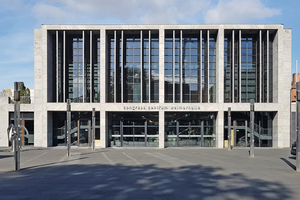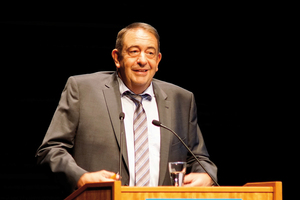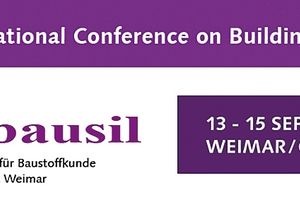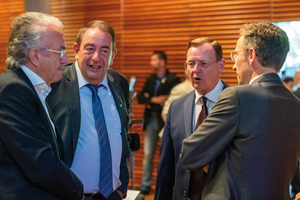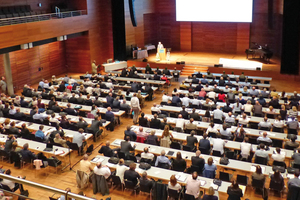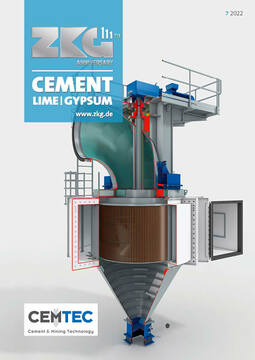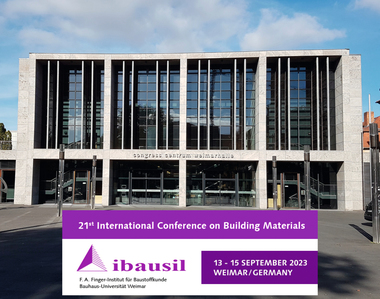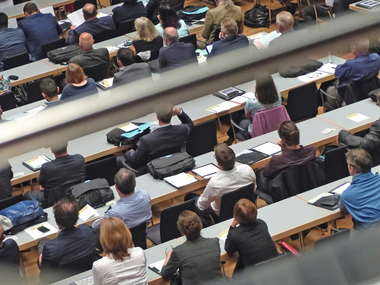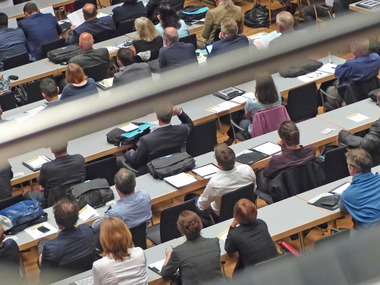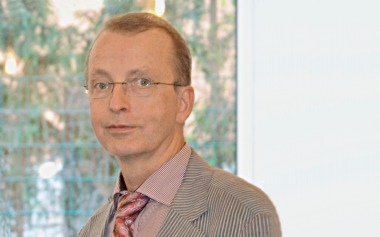Building materials – latest developments to be presented at ibausil 2023
From September 13 to 15, 2023, the 21st ibausil will take place in Weimar. After a break due to the Covid-19 pandemic, a highlight on the current state of knowledge in the field of building materials. New research and developments regarding the performance of building materials, especially also in the field of cement, lime, gypsum and concrete, will be presented. Another very important item on the program will be sustainable, preferably CO2-neutral or CO2-saving production. Contributions can still be submitted for next year’s international conference, and the organizers are looking forward to receiving as broad a spectrum of topics as possible on the current state of research and practice. The extended “Call for Papers” ends on December 31, 2022. In an interview with ZKG Editor-in-Chief Dr. Petra Strunk, Prof. Dr.-Ing. Horst Michael Ludwig went into more detail about the main topics and explained which current and exciting topics await participants at ibausil 2023.
You should not forget that it is not just about cement and concrete, but that we deliberately focus on wall ceilings and floors, where other building materials come into play. We definitely don’t want to ignore these, and they should really be present at ibausil. Of course, cement and concrete are dominant due to the scope of this building material, but the other building materials will also be represented in the future.
In 2018, the 20th ibausil took place. We now have a three-year cycle, it used to be different, there was the ibausil every two years. The regular ibausil would have taken place in September 2021. Preparations were already underway, but then it became clear that this would not happen because of the pandemic. Fortunately, we were still able to stop the work, even though costs had already been incurred. The ibausil was then immediately postponed by two years to 2023. That seemed safer to us in any case. In addition, we thought that there would probably be an absolute conference backlog in 2022, so we went straight to 2023.
The beginnings of ibausil go back a long way. There was an annual graduate meeting for graduates of the building materials faculty at the Bauhaus University, then the universal university for architecture and construction in the GDR, starting in 1958. From the 5th meeting, in 1964, it was decided to hold this as an international building materials conference. In 1964 there were already 200 participants. That was the first ibausil. That was still manageable, but the meeting grew more and more. Both the participating countries and the number of participants went through the roof. Shortly before the fall of the Wall, in 1988, the last GDR ibausil was held, and by then about 800 participants had already come to ibausil. But the number of countries of origin of the participants leveled off at 10 to 13. After the fall of the Berlin Wall, the organizers considered how and in what format ibausil should continue. In fact, the first all-German ibausil was held in 1991, but the number of participants dropped significantly. At that time, there were only 250 participants. Over the years, the number of participants has increased again. The ibausil now has 600 to 700 participants from 30 to 40 countries.
ibausil is also subject to the changing times. In the past, it was already bilingual, at that time German and Russian. After the fall of the Wall, it was German and English. Whereas, since ibausil 2015, we often offer simultaneous translations from German to English and from English to German. So that was not so long ago. We were also asked if we didn’t want to transfer the conference completely into English, but that would lose the point of this conference. We still want to offer a large, also German-speaking, international building materials conference. Our aim is to offer an intersection between the purely scientific conferences that often exist in this world and the practice-oriented conferences with a strong industry dominance. Both sides, i.e. industry and science, should come together, meet and exchange ideas. The participants can cross-fertilize each other casually and in a good atmosphere. That is the goal. This also includes the fact that many smaller German companies are regular guests at ibausil, and they should be able to continue to participate. That is why we will definitely keep the conference bilingual. In the main plenary hall there will be simultaneous translation German – English, English – German.
We will arrange the incoming lectures in such a way that the international lectures and the main lectures, which then also address a broad audience, will take place in the main lecture hall. And in the side lecture rooms, only national discussions and presentations have been held so far anyway. So we bring both sides together well. Participants can always choose which session they want to attend. The lectures in the main hall alone are a full fledged conference. The more application-oriented topics, which are then also particularly German topics, are presented and discussed in the side rooms.
We have many national projects, which is our great advantage, and I am very grateful for that. I travel a lot around the world and also in Europe. In no other country is there such a funding culture as in Germany – via the German Research Foundation, via the Ministry of Economics, via the Ministry of Science, via the German Federation of Industrial Research Associations (AiF), via many other funding platforms and sponsors. We are really very well positioned in Germany.
Who exactly is ibausil aimed at? Who should definitely participate in ibausil?
ibausil stands for International Conference on Building Materials and Silicates. It is all about silicate building materials. Our focus is clearly on building materials. This sets us apart from other conferences that are in the technology sector. Here, there is a certain focus on cement and concrete, and then we also have one of the five focal points on ceiling flooring and wall building materials.
And who is ibausil aimed at? As already mentioned, it is intended to form a link between basic research and applied research, between academia and industry. Consequently, we have a very broad range of participants. You will find top scientists from abroad, you will meet almost all German professors in the field of building materials at ibausil, but you will also find representatives of large-scale industry in the field of building materials; you will also meet the large construction companies, and you will also meet the core of our economy and industry, the medium-sized companies. Furthermore, we feel that we are not only a link between industry and science, but also between East and West. We have very many Eastern European countries at ibausil, but also very many Chinese colleagues, who will hopefully be able to come again this year.
I think it is good that we are not a purely scientific conference, but occupy exactly this space. On the other hand, we also have the claim to communicate basic science here.
That is right. So the main topic 1 covers inorganic binders and this point covers subjects such as carbon capture, storage and utilization, as well as alternative and low CO2 binders. This fits together well. The Association of German Cement Manufacturers has drawn up a CO2 roadmap that summarizes the key technologies and measures needed to achieve climate neutrality by 2050. The clear objective is based on the carbon capture approach, but whether this is storage or utilization remains to be seen. This means that the CO2 which is produced during the manufacture of Portland cement clinker, is no longer released into the atmosphere, but is liquefied using suitable technologies. Then this CO2 can either be captured, i.e. stored, as is done in Norway or elsewhere, in the North Sea, either in free gas spaces where gas was produced or in other cavities. This will not be possible in Germany. For us, it is then also a question of how we use this liquid CO2 further, for example in the chemical industry. In the building materials sector, we are considering how to use the CO2 as it is, for example by carbonating specific building materials or specific products in order to achieve certain product properties. Then we would have achieved two things: We would have bound the CO2 and possibly also manufactured new products with it. That would be a great story, of course. Then there is the use of alternative hydraulic binders. That is the actual strategy. You want to produce as little Portland cement clinker as possible in the cement kiln. By using suitable composite materials, that‘s what we will also be dealing with at ibausil, to reduce the CO2 that is produced. And the remainder of the Portland cement clinker, which is still absolutely necessary and cannot be substituted, will then have the CO2 removed by carbon capture. So that we really do have a CO2-neutral cement plant.
This will probably be the absolutely biggest point at ibausil. That is also where the most is happening at the moment. The cement industry is really changing. I am also chairman of the B1 committee at the DIBT, that is, the committee where new binders that don’t yet fit into the standard are approved and have to undergo additional testing. And there are completely new types of cement that are made possible by a new standard, that is DIN EN 196, Part 5, with the two types of cement CEM II/C-M and CEM VI. You can see how the cement manufacturers are very committed and really do submit a lot of applications for approval, especially in the CEM II C range. Until now, high clinker substitution rates in Germany could only be achieved with the help of blastfurnace slag in blastfurnace cements. There were the blastfurnace cements, which went into the CEM III/A, CEM III/B, CEM III/C range. This allowed the cement producer to replace a lot of Portland cement clinker. The substitution rate is currently limited at 35%. And now, with this new CEM II/C cements, they already have the possibility to replace 50% clinker with very different composite materials. And with the CEM VI cements, they can even replace 65% clinker. This expands the scope for action, and with all composite materials, not just granulated blastfurnace slag. From that point of view, this is a new way. And what we need to talk about is what happens when the granulated blastfurnace slag is eliminated because of direct reduction. And when the fly ash is really no longer available. But what happens after that? For that, there will be lot of activity in calcined clays. That will be one of the main points. A second important point is completely new binders. A lot is happening in this area, also in Switzerland. It is now possible to produce cements on the basis of magnesium rather than calcium. That, too, will take up a large part of the work. I will try to get my colleague Barbara Lothenbach, who has just been awarded a very large project in Switzerland, to give a plenary talk on this.
Self-healing sounds very exciting. How should I imagine a self-healing process to begin with?
There are three strategies: The simplest is the one that is already used in high-strength and ultra-high-strength concrete anyway. You have a large amount of cement there that cannot react because of the lack of water in these high-strength concretes. Then when the first crack goes in there, that crack naturally heals because the cement grain that hasn’t reacted until now then reacts and fills that crack again.
With normal concretes, we need self-healing mechanisms of a different kind, and for ecological reasons we do not always want to work with such an excess of cement. On the one hand, there is the way of adding suitable bacteria to the concrete, i.e., when the crack enters the concrete, these bacteria receive CO2 from the air via the crack, and these bacteria are then able to calcify, as it is called. We then set up a metabolism where they produce CaCO3, limestone, and fill the crack with that calcium carbonate. That is one way. And the way that now has to do with the sensors and actuators, that is that first of all we recognize somewhere that there is a crack. And that we add encapsulated repair substances into the concrete, this principle already exists in the plastics sector. The repair filler is encapsulated, so to speak, and is waiting to be used. Until now, it was the case that the crack had to hit the capsule directly in order to release it. That was not entirely satisfactory. That is why we are now going further and saying that there is then a signal that there are cracks and as a result a capsule opening is initiated for this area. In the capsule wall, for example, there are microwave-active substances that can be activated by microwaves, then the shell bursts and this reaction resin is released.
We will have the two focal points; recycling of old concrete and recycling of gypsum. We are very active in both fields, also in research, so as the Bauhaus University. But there are many other researchers who are active in these fields - for good reason. If the coal-fired power plants are really shut down, we will lose the important FGD gypsum, the flue gas desulfurization gypsum. At the moment, this accounts for more than half of the raw material used by the domestic gypsum industry. Unfortunately, the coal compromise states that these missing FGD gypsum quantities are to be largely covered by expanded natural gypsum mining. This is, of course, not justifiable at all. Especially towards the people who live in the corresponding regions, for example in the southern Harz. For this reason, there are large projects, also initiated by Thuringia, for example, but also nationwide projects in which attempts are being made to save gypsum. Either through composite materials that replace the pure gypsum building material, e.g. wood-gypsum composites or Pozzulan-gypsum-cement composites, or where one also tries to be able to create a higher recycling rate. These are the kinds of topics that science is dealing with at the moment, and we would like to exchange ideas about them. Of course, the gypsum industry is also represented in Weimar, and there will be an exciting discussion. By the way, politics will also be there. The relevant representatives of the offices, who then also have to deal with such issues. The second major topic is, of course, the recycling of old concrete. Here, too, there is an increasing scarcity in the aggregates sector - worldwide to a much greater extent than in Germany. There is an absolute shortage of sand in the Arab region. They have a huge desert on their doorstep, but the sand cannot be used for concrete production. There is really sand piracy there. There are beaches, because that is the sand that can be used, they are still there one day and the next day they are blown away and taken away by trucks. And the big buildings we see in Asia and the Middle East are built from imported sands from Australia. There will be an increasing shortage in our country, too, because mining permits are no longer being issued. Coarse aggregate will also become increasingly difficult. That is why everyone is being asked to do proper concrete recycling. This is not so easy either, because we have found it difficult to separate the individual components so far. We can only do good recycling if we can separate it well by type. Here, too, I am looking forward to the discussions at ibausil.
Where we need to make progress in all areas in the recycling sector and in the secondary raw materials we use is in environmental considerations. Here, other European countries are already much further ahead than we are. We still look at the solids content, while other Europeans only look at the eluates, for example, there is a very interesting material flow, namely steel works slag. There we will never get below a certain solid chromium content. This is not chromium that can be dangerous to us. What is dangerous is water-soluble chromium(VI), which is partly elemental chromium, partly trivalent chromium, but this is assessed and limited. We can no longer afford to send volume flows to exorbitantly expensive and possibly unsafe landfills that could be used well in the construction industry. We also need to be much more open about recycling.
When approving building materials, we always talk about recycling. And that is part of the approval discussion, that the new building materials that have been developed are also recyclable. Incidentally, this also played a major role in the discussion on carbon concrete, the non-metallic reinforcement substitute. How can we then also recycle this new material well? The manufacturers are already required to make the material usable in appropriate recycling concepts. Where we still need to take action is in the form of political framework conditions that also impose a certain obligation on users to use recycled material. Our colleagues in Switzerland and the Netherlands are clearly ahead of us in this respect. This is also reflected in the corresponding recycling rates in concrete.
There will be a new, non-harmonized standard, DIN 197 Part 6, where it will now also be possible to use fines from the recycling process in cement with the corresponding approval procedures. This is already a very important step in the cement sector. And we have also expanded the use of recycled materials by overturning the DAfStB guideline, which was in force for a long time. We now have standardization that leaves far more possibilities, but we still need the political framework. Recycling is still more expensive than natural materials. There must be political incentives and political regulations to encourage users to actually use this recycled material.
There have been a lot of developments in the field of building materials, where academics have thrown themselves into it, have done a lot of research projects, but which unfortunately did not make it into practice. For example, this famous ultra-high-strength concrete is only used in less than 1% of applications, even though many millions have been invested in research. And the second area is self-compacting concretes. This was also the absolute hit, concretes no longer having to be compacted with loud noise and compaction instruments. Here, too, we have very low application rates. We didn’t make the step from academia to industry. They were too complicated and not robust enough to manufacture. You had to manufacture very precisely so that the formulations didn’t tip over, and monitoring was extremely time-consuming. But I believe that 3D printing will find its way, and has already found it in some cases. Probably not for printing houses. I think you have to distinguish exactly, both economically and technically, where 3D printing makes a lot of sense, because we can work without formwork. Especially with complicated formwork, you can save yourself the trouble. You take a CAD program and then print that, partly also on demand, on customer request. In addition, there are of course components that you could not form at all. The geometries are so complicated that you cannot build any formwork at all. In this case, you can print without formwork. That would be the first steps into industrial 3D printing. Especially in the area of prefabricated parts, 3D printing will start its triumphant march.
I will certainly include this in the lecture on new types of cements that I will be giving. The topic of grey concrete, however, will not be a topic, because we want to initiate a research group or a graduate college at the DFG. But the two other main topics that I would like to work on there and where I would like to exchange ideas – recycled concrete and climate-neutral cement – will also be included there, as will the experiences of our colleagues from New Zealand, who have to pay much more stringent attention to this because they are an island and cannot just fetch raw materials from anywhere. They will then have to get into the cycle much faster than we do.
Yes, this is still possible until end of December 2022. We are looking forward to a broad and diverse participation!

